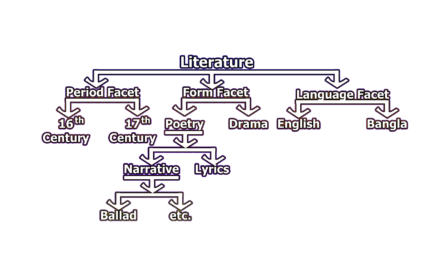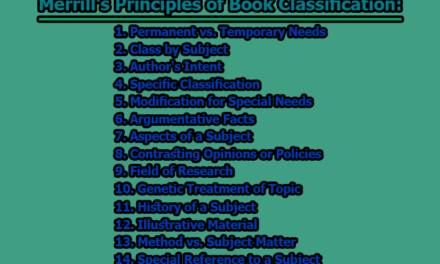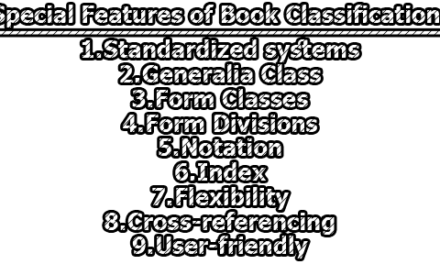Bibliographic Classification Scheme:
Bibliographic classification is the process of organizing and categorizing information resources, such as books, articles, and other materials, into a hierarchical system of subject headings or classes. This system allows librarians and other information professionals to create order out of the vast amounts of information available, making it easier for users to find what they need. Bibliographic classification systems typically use a combination of letters and numbers to designate subject areas and subtopics, with broader categories represented by fewer digits or letters, and more specific topics represented by longer strings of digits or letters. These systems are constantly evolving as new subjects and fields of study emerge, and as information resources themselves change with the development of new technologies.
Basic Principles of Bibliographic Classification Scheme:
Henry Evenlyn Bliss’s book, “The Organization of Knowledge Library” has included some principles of BC Scheme which are being in brief:
1. Educational and Scientific Consensus: Bliss assets that “Knowledge should be organized in consistency with the scientific and educational consensus, which is relatively stable and tends to become more so as theory and system become more definitely and permanently established in general and increasingly details.”
He believes that such an order would be the most helpful to library users. In this aspects we see many subjects have been added such as Media Science, Recording and Reproduction Techniques, Data Processing, Mining, Industrial Economics, etc.
2. Collection of Related Subjects: Related subjects are brought together into close proximity. For example; certain pure science are collected with the appropriate technology. This idea is similar to Brown’s. However, Bliss didn’t carry it to the extempore as Brown did in subject classification. Bliss brings together only those pure sciences and technologies which are most likely be used together by the readers.
3. Subordinate of Specific to General and Gradation in Specialty: In developing subclasses and subdivisions, Bliss ensure that relevant special subjects are subordinated to the comprehensive general subjects. In ordering of coordinate topics in an array, Bliss employs the principle of gradation in specialty. The premise of this principle is that certain derivative subjects draw upon the findings of other subjects. In a classification scheme, the subject that borrows from another is considered to be more specialized than the letter should follow it. For example; Mathematics is a Science that many other sciences draw upon and is therefore placed at the very beginning of the classification.
4. Alternative Location: Bliss recognizes that frequently a subject may be placed with equal usefulness in two or more possible localities in the scheme. In order to reader the system useful to the largest number of users, alternative locations are provided in the scheme for these subjects. For example; Economic history can be subordinated to general history or classed in Economics.
Alternative locations might be the placement of religion between history and the Occult or at the end of the scheme, and the opinion to concentrate all technology together in Class U, as an alternative to subordinating the more science-oriented ones with the appropriate science.
5. Alternative Treatment: Bliss also realizes that in some cases, a body of material may be organized in different, but equally useful, ways. In such cases, he provides alternative treatment in the schedules. A notable example is the four models of classifying literature
- Separating literary history from texts.
- Literary history and texts together
- Combination of (a) for modern literature and (b) for earlier literature.
- Same as (c) except that modern texts are classed by form rather than by author.
6. Notation: A simple notation is used. The Generalia Classes are represented by Arabic numerals. Subject classes are represented by single capital letters, and subclasses and subdivisions by a combination of capital letters, e.g.
U – Technology, Useful Arts
UE – Engineering
UHC – Construction Techniques
UHV – Architecture, Planning, and Building
UJ – Architecture Practice and Design
7. Auxiliary Schedules: There are six auxiliary schedules containing Concepts which occur in some way or another in all or most subjects. They may be applied to any class in the system. The notation is similar to that used in the main schedules; Arabic numerals, capital letters, or a combination thereof. The faceted structure of both the main schedules and the auxiliary schedules allows a great degree of synthesis. Six auxiliary schedules are:
- Common subdivisions
- Persons
- Language
- Ethnic Groups
- Periods of Time
The Systematic Schedules of BC Scheme:
Apart from the schedules of the main classes, there were originally nine tables called systematic auxiliaries schedules, which are being:
Schedule-1: Numerical subdivision of any class or selection, mnemonics: Some constant, some adaptable (numerals).
Schedule-2: For Geographical Subdivision (Lower-case letters): used where required for local subdivision of topics under sciences, especially social sciences, under the humanities, Industries and Arts, but not under History, Human Geography, Ethnology, Language and Literature, where other tables are provided. For examples;
a – America c – Latin America
aa – North America ca – Maxico and Central America
ac – Canada cb – Mexico
ad – Eastern Canada cbm – Mexico City
and – Newfoundland
Schedule-3: For subdivision by language (Capital letters, sometimes preceded by a comma to prevent confusion): Applicable under literature, especially for the “forms”, for translations, etc. This table may be applied elsewhere instead of schedule-2, to Arts, Modern Philosophy (AD), and to the history of science like schedule-2, this table is mnemonic and practical rather than systematic. Examples are;
, A – Ancient , P – Polish
, C – Latin , R – Russian
, F – French , W – China
, I – Italian , Y – Japanese
Thus under AD, Modern Philosophy, AD, F represents Modern French Philosophy; AD, W represents Modern Chinese Philosophy.
The use of comma as a separating device is recommended when it is necessary to mark off the find capital added from an auxiliary schedules.
Schedule-4: For subdivision by historical Periods (Capital letters, preceded by a comma to prevent confusion):
- For subdivision under the history of countries, nations, states, etc. (figures and capital letters preceded by a comma)
- Supplementary for states, countries, duchies, provinces, cities, and other localities (Capital letters).
- For wars (Capital letters preceded by a comma)
Schedule-5: For subdivision of the philosophy of any language. Not applicable to the Chief literary languages (Capital letters):
- For the linguistics of the Chief literary languages (figure and capital letters)
- For the History and Criticism of the literature (figures and capital letters)
- For the “forms” of literature, especially for collections (figures and capital letters)
Schedule-6: For the arrangement of an author or philosopher works (figures, capital letters, and lower-case letters)
Schedule-7: For specification under any personage except authors and philosophers (figures and capital letters preceded by a comma). This schedule is applicable to the arrangement of all biography not covered by schedule-6.
Schedule-8: For Subdivision under Special Chemistry (CI-CR) (figures and capital letters preceded by a comma). examples;
, 2 – Bibliography , A – Chemistry of the Element
, 3 – History , F – Production
, 5 – Reports , L – Alloys
e.g., Under CK, Metals, is placed CN, Precious Metals; thus CN, F represents the Production of Precious Metals.
Schedule-9: For subdivision under Chemical Industries (CU-CY) (figures and capital letters preceded by a comma). Examples;
, 2 – Bibliography , A – Chemistry Study
, 3 – History , P – Costs
, 5 – Reports , T – Taxes
e.g., under CV, Organic Industries, is placed CW, Dyes, Pigments, etc., thus CW, A represents a study of the Pigment Industry.
The use of this auxiliary tables with the full schedules enables classification to be carried out in very great detail. In practice, they may be compared with the categorical Tables of the subject Classification and the specialized schedules of Universal Decimal Classification.
In conclusion, bibliographic classification is a systematic method of organizing and categorizing information resources in libraries and other information centers. It involves the use of controlled vocabulary and standard classification schemes to assign subject headings and call numbers to books, articles, and other materials. Bibliographic classification facilitates efficient and effective retrieval of information by users and enables librarians and other information professionals to manage large collections of resources.

Library Lecturer at Nurul Amin Degree College










